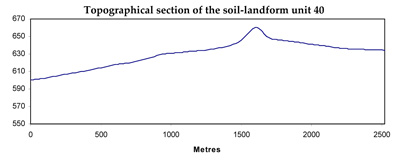Soil/Landform Unit 40
Landform Unit Description
Page top
 Stony outcrops occur on mid to upper slopes of gentle rises and plains east of Ballarat. Often these soils have never been cleared and remnant eucalypts indicate their position in the landscape |
0.01% of CMA region The lava plains south of Ballarat are characterised by undulating plains and rises that support many agricultural enterprises. This unit is further defined by the surface basalt boulders it has (stony rise or crest). Vegetation classes include Herb-rich Foothill Forest and Plains Grassy Woodland with the dominant species being manna gum (E. viminalis), narrow leaf peppermint (E. radiata) and messmate stringybark (E. obliqua). These areas have shallow stony red gradational soil with profile depths less than 80 cm. Agricultural land use is limited to grazing and potentially softwood or hardwood plantations. The shallow stony gradational soils are susceptible to leaching of nutrients, and compaction is a problem on minor stone-free areas. | 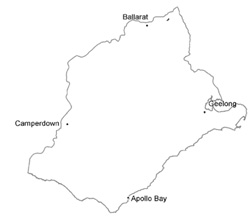 |
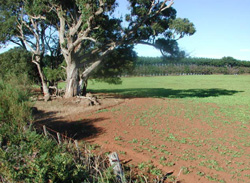 Manna gums (E. viminalis) are common remnants on these stony rises and crests | 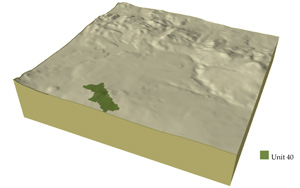 |
| 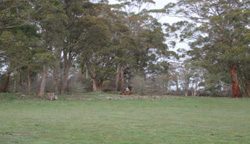 Remnant vegetation on a stony rise at Springbank |
Component | 1 |
Proportion of soil-landform unit | 100% |
| CLIMATE Rainfall (mm) | Annual 960 |
| Temperature (oC) | Minium 6, Maximum 16 |
| Precipitation less than potential evapotranspiration | November-March |
| GEOLOGY Age and lithology | Pleistocene basalt |
| Geomorphology | |
| LANDUSE | Uncleared: Nature conservation Cleared: Beef cattle and sheep grazing; softwood plantations |
| TOPOGRAPHY Landscape | Gently unudulating rises |
| Elevation range (m) | 600-661 |
| Local relief (m) | 6 |
| Drainage pattern | - |
| Drainage density (km/km2) | 0.3 |
| Landform | Stony rises |
| Landform element | |
| Slope and range (%) | 1-2 |
| Slope shape | Concave scarps, straight tops |
| NATIVE VEGETATION Ecological Vegetation Class | Herb-rich Foothill Forest (4.4%) |
| Dominant species | E. viminalis, E. radiata, E. obliqua, E. ovata |
| SOIL Parent material | In situ weathered basalt |
| Description (Corangamite Soil Group) | Red shallow, stony gradational soil (40) |
| Soil type sites | |
| Surface texture | Clay loam |
| Permeability | High |
| Depth (m) | 0.8 |
| LAND CHARACTERISTICS, POTENTIAL AND LIMITATIONS | Shallow, permeable soils result in overland flow and nutrient leaching. Sheet erosion can also occur with significant rainfall events and inadequate ground coverage. |

